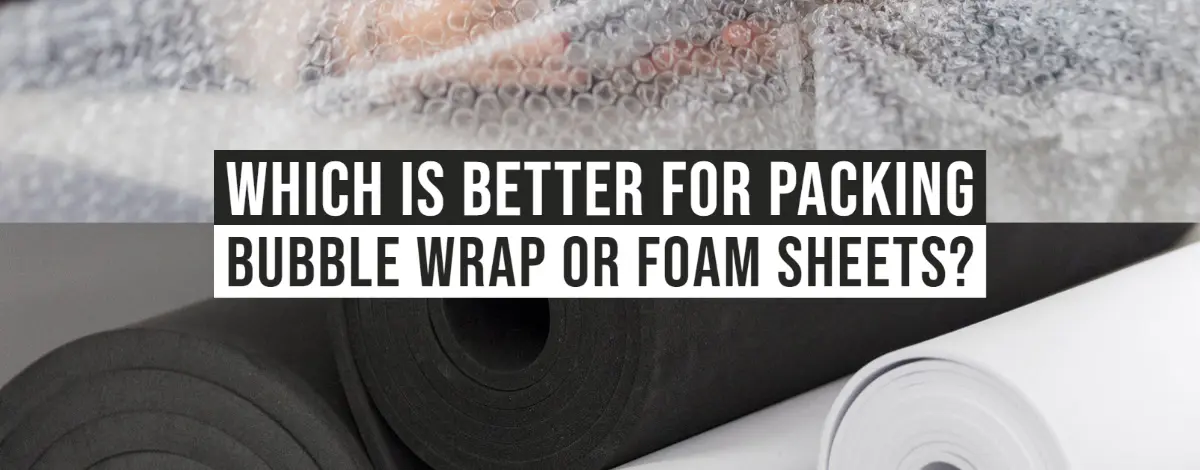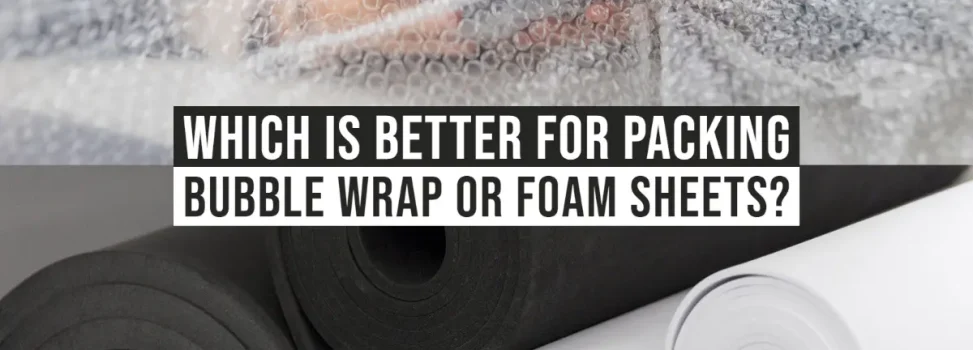As experienced movers will attest, careless packaging is the leading cause of harm and loss during relocation. There are many different types of packing supplies available, ranging from bubble wrap and mattress wraps to moving blankets and foam sheets.
Which is more effective, nevertheless, for breakable things like plates and framed pictures? Foam sheets or bubble wrap? We’ll explain each option’s benefits and drawbacks to assist you in selecting the best option for your relocation.
What Distinguishes Foam Sheets From Bubble Wrap?
Both bubble wrap and foam packing materials are more expensive, thin, and versatile than paper packaging supplies. These are of similar quality that bubble wrap and foam packing materials also have. You may cut down on wrapping time as well as supplies by being aware of when to utilize each one.
If you’re lucky enough to be able to engage experts in moving, ask them for their opinions and recommended methods for the packaging.
Ignoring the urge to pop bubbles on the bubble wrap is an unavoidable desire if you’re performing a DIY shift! And here’s our suggestion: get out of here and stop feeling so stressed out about the relocation.
Packaging with bubble wrap:
The process of creating bubble wrap, also known as bubble cushion, involves holding air in spherical cells between two coats of plastic. This procedure endows the packaging material with good moisture resistance and great shock absorption.
The bubble wrap comes in three different air cell sizes. One of the most widely utilized sizes for wrapping delicate household objects during a relocation is a 3/16′′ bubble cushion. Fragile home items are commonly packaged with the next size up, 5/16′′.
You might consider the mini cell size more adaptable for covering mugs and drinking vessels, and great for little ceramic or glass models, but it depends on your individual opinion on which size fits best.
How and When to Use Bubble Wrap:
Bubble wrap is available in tiny and big rolls as well as cut in advance sheets, so it’s simple to choose the ideal size and shape to safeguard and secure your household goods for shipment.
Because you’ll require to cut the rolls into individual pieces using a box cutter or knives, rolls operate best for wrapping heavy objects like plasma screens, framed pictures, and big, fragile works of artistic creations or devices.
Bubble wrap rolls and sheets are initiate-sized and punched, which limits their application to objects like dishes, cups, and tiny pieces of painting for framed images. It’s important to remember that the sheets don’t always damage quickly and that finding the hole can be difficult.
But if you’re prepared to separate the sheets in advance from the rolls and create a pile, covering and arranging will go much more quickly.
Fragile goods like glasses or decorations should be wrapped in bubble wrap since it offers good impact protection.
Additionally, it shields fragile items from knocks while in transportation, it is more effective for fragile items to be shipped or dispatched.
Due to its thickness, bubble wrap is superior to foam wrap for filling voids and securing objects in boxes.
Can bubble wrap be recycled?
Get inventive when it comes to recycling your used packaging supplies to be environmentally friendly. By utilizing the foam sheets again to wrap and keep holiday items, you may extend the money you invested in them during your relocation. If you have college-aged children, carry an additional shifting box filled with bubble wrap on standby for care packages.
Selecting Foam Sheets:
Several artificial components are used to create foam, which is a lightweight but dense substance. Due to its narrow width and low density, this item is perfect for covering a variety of everyday things.
The pre-cut nature of foam sheets makes them perfect for wrapping items like expensive china sets, computers, hard discs, champagne flutes, photo frames, and lamps. You can stuff more into your moving box by using foam wrapping because it is lighter than bubble wrap (but resist the urge to pack your fragile things!).
Rolls of foam and pre-cut sheets are excellent for padding possessions and protecting surfaces. Placing foam sheets between stacked dishes and tableware is simple. Covering antiques and picture frames are simple with foam sheets.
Foam is used by qualified moving professionals to wrap the legs of furniture to protect their surfaces during transit. Using foam sheets is simple as well. They are less clumsy than little bubble wraps since they are thin and highly adaptable.
Utilizing foam wrap when:
Although foam wrap is lighter than bubble wrap, it still offers padding.
Furniture should be wrapped in it to prevent scratches and stains when being moved.
Given that it is more adaptable than bubble wrap, it is especially well-suited for furniture legs and feet.
It can be utilized to pack crockery and accessories without taking up a lot of room in shifting boxes.
You can shield lights and TV displays with a flat sheet of foam.
100% recycling capacity of foam wrap.
What Is the Best Option Between Foam and Bubble?
As always, the answer is dependent. Making a decision can be challenging because the two packing materials share so many similarities (and there are so many alternatives). You will probably find the answer you’re seeking if you demand some clarifying queries from yourself.
1. Do you need structural support, gap fill, or item security?
2. Are you moving to a new house, securing components, or packing up business goods?
3. Do you want a defense against structural or aesthetic harm?
4. Do your products have a uniform shape or are they atypically formed textured or flat?
5. Are your goods expensive, delicate, heavy, or bundled with other items?
You’ll encounter instances when the foam vs bubble debate will cross your mind, whether you’re relocating to a new house, liquidating valuables, or shipping goods and materials. You must choose which best meets your demands out of the two options because they each have advantages, practical uses, and fascinating applications. Since The packing Company is passionate about wrapping in all its forms, please feel free to reach out to them if you have concerns about the best packaging materials for you.
Which material suits you best?
Although both supplies are excellent options for secure packaging, their unique features make them superior for various applications. As with all packaging, we advise using the appropriate material for the job at hand, so consider your intended use before deciding on what type of material to use.
A wonderful all-around protection is bubble wrap. Whether you’re packaging small items or big, fragile ones, air cushioning provides a superb layer of protection. There are many different item sizes and weights that can be accommodated by readily accessible densities. It may cause traces on glossy and reflecting surfaces, so you should be mindful of that.
With foam wrapping, you can keep more square meters on location, and it will take up a smaller area in boxes because it is typically less dense and softer than bubble wrap. It’s fantastic for pottery, huge electrical devices, furnishings, or highly polished pieces like alloy wheels since its flawless touch won’t leave a single trace on items. It’s also ideal if you’re transporting fragile things with superior shiny surfaces.
Packaging is always weighed against cost. Regarding cost per square meter, both materials are very identical. Keep in mind you use the appropriate depth and quality for your requirements to keep your packaging affordable. A 1-mm string of foam has 3 times as many square meters as a roll of little bubble wrap.
Using bubble wrap and foam wrap:
If you’re shipping something internationally or over a long distance, it’s best to wrap it in layers of bubble wrap first, then foam wrap.
When arranging numerous of the same things, like dining plates, the two also cooperate.
Within every plate, there is a layer of foam wrap, and the entire thing is then wrapped in bubble wrap.
Foam and bubble wrap can both be sealed with packing tape.
FAQs About Which is Better for Packing Bubble Wrap Or Foam Sheets
1. It Isn’t Biodegradable.
Although consumers can frequently make several trips with a roll of bubble wrap, the majority of brands are not biodegradable. Even though this has altered recently, you should be aware that when you buy bubble wrap, it can end up taking up an area of waste.
2. Storing Presents A Challenge.
Although bubble wrap doesn’t weigh much, when it’s folded up, all those tiny air pockets seem to take up a lot of room. That implies that you either need to buy bubble wrap regularly or utilize an enormous amount of space inside to fit it.
Most frequently utilized in wrapping for pressure and shock resistance, movement dampening, and exterior security, EPE Foam is a light, semi-rigid, stretchy sealed sheet foam.
An efficient and environmentally friendly form of packaging is foam sheets.


